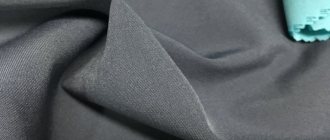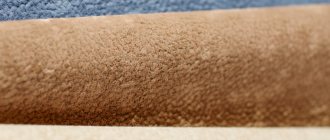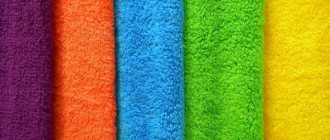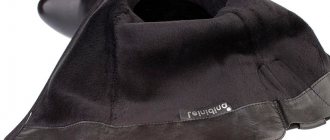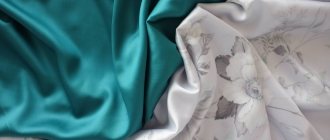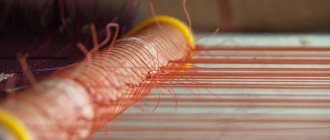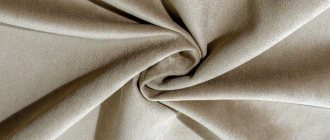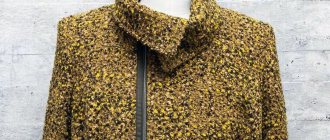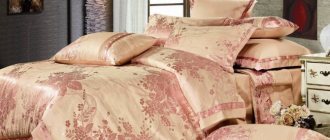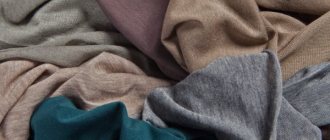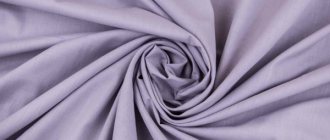Cupra (cupro) is an artificial material that is superior in quality to many natural fabrics. It is very light, soft, easy to handle and simply beautiful. The name “cupra” comes from the foreign word cupro, which means copper. What cupra fabric is – and how its name is related to copper – we will tell you in the article. And also about its properties, composition and application.
Cupro - what kind of fabric?
Cupro is not a natural fabric. Its name comes from the Latin word cuprum, which means “copper”. To make cuprous fiber, they take wood chips, cotton tow, and coconut fiber. Such raw materials contain cellulose.
The raw materials are treated with a mixture of copper sulfate and ammonia. Then the resulting mass is passed through a metal sieve. Strong and shiny threads are formed - cuprous fiber. They are treated with sulfuric acid to make them smooth, soaked and made into fabric.
Cuprofibre is added to other types of fabric to obtain new properties. It contains taffeta, viscose, artificial silk, satin, jacquard. Cupro gives other materials crease resistance and strength. Dense, non-stretchy fabrics containing cupro provide a better fit.
The colors of the material are rich in variety. It is easy to paint, the color is bright and durable. There can be either plain or patterned colors.
Types of fabric:
- tweed;
- jacquard;
- knitwear;
- atlas;
- boucle;
- velours;
- brocade.
See fabric review:
This is interesting: Fabric eraser: composition, description, care recommendations
How to care
Expensive and beautiful things made of artificial silk deserve the most careful care. They can be dry cleaned or washed at home. Cupra requires washing by hand or in the gentle cycle of the washing machine. The water should not be hotter than 40 degrees, and the detergent should be chosen as soft and neutral as possible. It is better to do without a machine spin and in no case should you use the machine drying mode. The products are easily wrung out by hand and straightened.
The elasticity of copper-ammonia fibers can deteriorate from the influence of sunlight and heat, so products made from such fabric should be dried indoors, away from heaters and radiators. Under no circumstances should you iron fabric that is not completely dry. You only need to iron things from the inside out, setting the iron heater to the “Silk” mode.
Advantages and disadvantages
Cupra fabric is unique in structure. It is durable and elastic, light and smooth, with a soft, noble shine. The fibers are easy to dye and retain color for a long time. The thin cupra fabric is pleasant to the body, it allows air to pass freely and at the same time retains heat. Among the disadvantages of the fabric, one can note the long and complex production process, as well as the high cost. In many European countries and the USA, the production of cupra has been stopped due to the negative impact of its production processes on the environment.
Properties and Features:
- softness and smoothness;
- breathability;
- hygroscopicity;
- good thermal conductivity;
- firmness and elasticity;
- ability to drape;
- elasticity (fabric does not wrinkle);
- resistance to fading;
- thermoregulation property;
- strength in dry and wet conditions;
- thin and light;
- does not shed.
Advice! The beautiful volatility, elegant shine, close-fitting silhouette and special elasticity of cupra allow it to be used in sewing expensive evening and weekend wear - dresses, blouses, suits.
Cupra materials are comfortable to wear - in summer they pleasantly cool the body, and in winter they warm well. The fabric is used for sewing a wide variety of clothes - elite casual and elegant, as a lining for expensive outerwear - coats, jackets and fur coats.
Cupra and its varieties
Cupra is used to produce various types of fabrics:
- Satin and crepe satin are smooth, dense fabrics with a strong shine. Its beauty and strength are due to satin weaving: the weft thread appears on the front side after 5-7 warp threads.
- Brocade is a heavy, dense material with an unusual pattern. Gold, silver, and other metal threads are used for decoration, which determines the weight of the brocade. The peculiarity of the cupra material is that it can withstand the weight of gold threads despite the thin thickness of the fabric. This brocade is thin and light.
- Tweed - twill weave produces an analogue of tweed. It holds its shape perfectly and is suitable for summer suits. Much more often, cupra is mixed with wool to produce high-quality tweed that is light and shiny.
- Jacquard – jacquard weaving forms voluminous complex patterns on the surface of the fabric. The fabric, like damask, is not dyed, but colored threads are used in its production. This method is used to produce carpets, upholstery for expensive furniture, bedspreads, and outerwear.
- Bouclé is a material with a fibrous, knobby surface. The weaving is simple - plain, but the basis is shaped yarn with knots and thickenings. Cupra bouclé is thin and soft like silk, and the shine emphasizes the relief of the surface.
- Velor is a soft and fluffy fabric that can nevertheless be made from thin threads.
The finest silky velor is used to make first-class clothing.
In the manufacture of various materials, cupra is mixed with wool, cotton, natural silk, and synthetic fibers. The properties of the canvas depend on the proportion of each “ingredient”. Read about knitwear from Ivanovo and Zlata’s clothing catalog here.
Description and composition
The name of the fabric is a reference to its composition. Copper is actually included in the fabric. The main raw material is wood cellulose. It goes through a complex chemical and technological processing process. Thus, cupra is a rare variety of high-quality viscose. In terms of external characteristics and tactile sensations, it is close to natural silk.
Interesting fact: The discovery of cupra occurred by accident in the 20th century, when cotton crops were treated against insect pests with copper sulfate. Today it is classified as an expensive fabric with impeccable appearance and high consumer characteristics.
Acid treatment makes cellulose fiber as thin, long and transparent as possible; the admixture of copper salts in the composition gives the material strength and resistance to mechanical stress. Cotton inclusions make cupra products easier to care for and comfortable to wear.
Composition and production
At the beginning of the 19th century, German scientists for the first time managed to obtain fiber based on cellulose and cotton, which was used to make lining fabric. Today, Germany also remains the main supplier of cupra material on the world market. More recently, Italy and China joined it.
Cupro fabric contains cellulose chips from various tree species, as well as cotton tow and coconut bark. All components are combined and then dissolved in a copper-ammonia composition. As a result of this process, a viscous dark-colored mass is formed. It is filtered, diluted with sulfuric acid, then shaped by passing through a sieve with tiny holes. The resulting fiber is very long, thin, and absolutely colorless. It is twisted into threads, from which cupra fabric is subsequently woven.
The production of cupra fiber uses compounds that pollute the atmosphere, so it is considered harmful and is banned in many countries.
How to choose the right care
They choose high-quality cupra based on density and appearance; products made from this fabric are expensive. Beautiful designer items require special treatment - the most gentle care possible. It is recommended to dry clean outerwear items.
Caring for cupra fabric products:
- hand wash at 30 or 40°;
- delicate machine wash;
- mild detergents with neutral PH;
- without machine spin;
- without automatic drying;
- Iron on low setting on reverse side.
Advice! It is recommended to iron cupra products only when they are completely dry. Wet fabric is quite vulnerable to heat and steam.
The products are carefully squeezed by hand: wrapped in a towel and gently pressed so that the terry cloth absorbs moisture. Then the cupra product is straightened and dried in a horizontal position, in the process protected from contact with hot air and direct sunlight. Products are stored on hangers and folded, since the material does not stretch and does not form creases.
Cupra is multifunctional in its application - clothing, casual and elegant, textiles and interior items. Things made from cupra are stylish and comfortable to wear, they are suitable for any season and different weather. High-quality cupra carpets are highly valued; they will adequately decorate a home.
Application
- The first thing that needs to be said about the use of cupra is that different types of fabrics are created from it (we have already talked about this)
- Used as lining material. Cupra lining can be used on skirts and dresses, as well as on outerwear.
- However, dresses, skirts and blouses can consist entirely of this material
- Same as capes and some outerwear items
- The material is good for creating home decorative textiles: bedspreads, draperies, furniture upholstery
Useful: supplex fabric - description and reviews.
Cupro fabric (cupra)
In its properties, cuprofibre is very similar to silk and belongs to elite and expensive materials .
Material manufacturing technology
The name cupra material comes from the Latin name for copper and is directly related to the fabric production technology, which was discovered at the beginning of the twentieth century. Various types of plants , coconut, cotton and wood, all containing cellulose, are used as raw materials for the production of artificial cupra fabric An interesting feature of the technology: in order to obtain high-quality, elastic and at the same time smooth fiber, a solution of copper sulfate and ammonia is used to process cellulose. As a result, thin but strong threads are formed, which in the fabric are very similar to silk.
Material properties
- Smooth and shiny fabric of good quality , feels like silk.
- The softness of the fabric base, the fabric has a pleasant tactile feel to the body.
- Cupra “breathes” and is hygienic.
- Absorbs moisture well.
- Comfortable fabric at any temperature, has its own thermal regulation, it will not be cold in winter and hot in sultry summer.
- Durable and elastic texture, durable use of the product.
- Fits beautifully on the figure, forms spectacular draperies, looks stylish and expensive.
- Does not wrinkle or break, practical for everyday use.
Initially, the fibers obtained during the cupra manufacturing process are colorless. When painting, the composition perfectly accepts paint pigments and does not fade over time.
The disadvantage of cupra is the production process technology : during the chemical processing of cellulose, environmentally harmful production waste is generated.
Therefore, in developed countries of Europe and America, the production of fabric is either prohibited, or high environmental requirements . Generally, the cleaning cost is expensive, which significantly affects the production cost. Therefore, the fabric is expensive and is rarely used in its pure form. But as an additive to cheaper threads they are used everywhere.
It should be noted that when wet, the strength of cupra threads is significantly reduced.
Use of cupra
Cupra is often used as a mixed fabric in combination with viscose, which gives strength and ductility to the product. Clothing made from such a mixed material has a “flying” silhouette and excellent fit . If cotton or acetate fiber is used as an additive to cupra, the manufacturer receives a lining fabric that is durable and looks beautiful.
The combination of cupra with wool is used to make practical outerwear and men's suits. Cupra allows you to produce all sorts of stylish fabric textures, such as boucle or tweed. Cupra is used in the manufacture of high-quality carpets in the elite price category, which are particularly soft and bright in color.
Cupra is an elite and expensive fabric. For greater elasticity of the fabric and strength of the product, special dilon threads are often added to it. Outwardly, such a fabric can resemble any expensive fabric, and the textures surprise with their diversity. The surface of the canvas can be fleecy and velvety or shiny and embossed.
Types of cupra
- Elastic knitted fabric.
- Delicate velor, soft and velvety.
- An interesting jacquard with a complex weave of threads.
- A spectacular brocade for special occasions.
- Smooth and shiny satin.
If the fabric is thin, cupra is used for sewing elegant women's clothing : flowing dresses and skirts, blouses, with draperies and iridescent folds. Such products look expensive and stylish. They are preferred by movie and show business stars, popular and famous personalities.
Suits for festive events are made from denser materials that contain cupra. Cupra is actively used by interior designers for upholstery of luxury furniture and as textile decorations, for example, expensive curtains.
It is worth noting the special quality of cupra knitwear, which is characterized by plasticity and elegance. Wearing knitwear made from cupra is very comfortable and convenient. Cupra fiber is often used as an additional additive to silk fabrics; this does not affect the quality of the fabric, but gives the product strength; such clothes do not shrink or lose their shape.
How to care for products
Caring for cupra products requires special care. When cleaning household items, it is better to use the services of professionals. If these are mixed clothes made from a combination of different fabrics with cupra fibers, you can wash the products at home.
It is best to use hand wash, or at least a delicate machine wash. The water temperature should not be high, below 40 degrees Celsius.
Use specialized detergents for wool and silk. Washing should be gentle, without active rubbing movements; remember that when wet, cupra loses strength and the product can be deformed.
After washing, lightly wring out the material, place it to drain the water , then straighten it and dry it horizontally on a special drying grid. You should not take your clothes out to dry in the sun, as this may deteriorate the quality of your clothes.
It is better to iron cupra products from the wrong side with the iron at low heat.
Tip: iron only after cupra items are completely dry; damp fabric may stretch when ironing. When dry, the fabric is not in danger of deforming, so storing clothes is acceptable either folded or on a hanger in the closet.
This is interesting: Bologna fabric: description of properties, characteristics, use
For what purposes is it used?
The unusual fabric is widely used:
Cupra mixed with cotton or acetate fiber is a beautiful lining fabric.
A material combining cupra with wool is used for sewing suits and coats.
Soft and bright high-end carpets also contain “copper” fibers.
Smooth cupra is ideal for elegant women's clothing.
Stage costumes are made from dense samples.
Interior designers use cupra for upholstery of designer furniture and as textile decorations.
A popular blend of cupra and viscose fabric produces durable, bright and flexible outfits.
What is made from cupro?
This is a 100% artificial, durable and versatile fabric that is successfully used in various areas of the textile industry. Cupra is used to make elegant dresses, blouses, suits, skirts and other types of clothing.
Elastic and thin fabric emphasizes the beauty of the female figure. Famous Italian textile manufacturers create unique fabric options designed for sewing fashionable clothing models of modern designers. Particularly popular is cupra-dillon, painted in bright shades with beautiful floral motifs.
Another type of cupra, lining cupra, is also in great demand. It is used for sewing outerwear, jackets and trousers. One of the leading fashion houses Dolce & Gabbana produces jacquard cupra lining. This fabric has superior characteristics to silk fabrics due to its plastic structure and excellent breathability. The diagonal type of weave of threads makes the material highly resistant to wear and makes it durable.
Upholstery cupra is used to make furniture covers and upholstery. Covers for decorative pillows and bedspreads are also made from it. The fabric drapes well, so it is often used to make curtains, curtains and lambrequins.
Cupra combines well with other types of fibers. The presence of viscose in fabrics makes them durable and flexible - products made from fabric with viscose fit the body and make the silhouette soft. A mixture of cupra and wool makes it possible to obtain a material from which high-quality men's suits and some models of outerwear are sewn.
Production of material
To understand what cupro fabric is, you need to understand its origins. The name of the product reflects the method of its production. Cupro means copper in Latin. This type of textile is produced artificially, but its base is completely natural.
The material is created from cellulose chips and cotton fluff, which are treated with a copper-ammonia solution. Often, manufacturers, in order to improve the quality of the fabric, add coconut fiber and cotton floss to its composition. From these raw materials a viscous mass is obtained, which must be passed through a special filter. The long, elastic and thin fibers obtained during the manufacturing process are transformed into smooth threads.
Cupro fabric is rightfully considered the highest quality type of viscose textile.
However, in many countries the production of this material is prohibited. This is due to the chemical treatment of the substance, which is harmful to the environment.
What types of fabric are there?
High technical characteristics have determined the wide application of cupro in the textile industry. The following types of fabrics are made from such fibers:
- tweed;
- jacquard;
- knitwear;
- atlas;
- boucle;
- velours;
- brocade.
The varieties of cupro described above have found application in clothing production. Such canvases are valued by famous designers, from which they create flowing outfits. However, tailoring is far from the only area.
Reviews
Anna. I have been sewing dresses to order for more than 10 years. I use cupro as a lining from time to time. An excellent material for summer - lightweight, breathable. The skin does not sweat at all!
Victoria. I have a skirt made of this material. It looks simply stunning and is great to wear! The fabric stretches well, does not restrict movement and does not wrinkle if you sit somewhere in public transport. Very pleased.
Inna. As a professional, I’ll add that this fabric is far from cheap. Draperies are often made from it, and this is a costly business. However, the result is worth the money. The end result is very elegant and even somehow royal.
Kinds
Cupra fabric is interesting because it can reproduce the external qualities and characteristics of any fabric of natural origin. Suit cupra can look like tweed and bouclé, fine wool, satin and linen. Fashion designers prefer to work with cupra because of its effectiveness, variety and practicality.
Cupra fabrics - varieties:
- Thin cupra . This is 100% cupra fiber. The weightlessness, translucency and flowing properties of the fabric allow it to be successfully used for sewing incredible designer items - cocktail and evening dresses, floor-length skirts and loose trousers, tight-fitting blouses and original capes.
- Knitwear . Cupra knitwear is of high quality - it looks beautiful, does not stretch, does not fade or wrinkle. To increase strength, synthetic Dilon threads are added to the fabric composition, which allows the fabric to be practical and not shrink after washing.
- Velor . This is a cupra fabric with a fleecy front surface. Soft and pleasant to the touch, it shimmers beautifully in the sun and hugs the body.
- Dense cupra . Among the varieties of cupra fabric there are materials with the effect of brocade and jacquard. Interesting texture and color variety make them popular for sewing festive women's clothing.
Fashion designers also use cupra to create unique interiors - in textiles, curtains, decor and upholstery. Cupra blend fiber is used to make premium carpets and rugs. They are distinguished by durability, pleasant texture and rich colors.
What is the price
cupro material
how to wash cupro
what is cupro in fabric composition
cupro fabric composition what
The price of cupra material depends on the manufacturer, quality technology, additive composition, if it is a mixed material. Lining fabric costs from 540 rubles, dress and suit fabric from 950 to 1580 rubles.
Material properties: pros and cons
Both natural and artificial fabrics have their advantages and disadvantages. Cupro is no exception; the advantages of this fabric include the following qualities:
- Lightness and softness of the fabric. Cupra clothing is very comfortable, it gives a pleasant feeling and does not restrict movement at all.
- High level of hygroscopicity. This characteristic makes the material similar to natural fabrics that absorb and retain moisture well.
- The ability to pass air molecules through. Thanks to this feature of the material, things made from cupra allow the body to “breathe”.
- Maintaining heat exchange. Made from 100 percent cupro fiber, Cupro provides excellent heat retention in cold weather, keeping you cool on hot summer days.
- Good drape. The elasticity of the material allows you to create beautiful folds. Cupra dresses perfectly fit the figure and highlight its advantages.
- Preservation of shape. Things made from cupro fiber hold their shape well and are not subject to creasing.
- Resistance to deformation. The material does not shrink when washed and does not lose color.
The value of the canvas is explained by its special silky texture and shine. Some people use the term “wet silk” to refer to this fabric. However, despite all the advantages, Cupra is not without its disadvantages:
- When wet, the fabric becomes less durable. After drying, the strength of the material is restored.
- The presence of viscose fibers in the fabric leads to the gradual formation of pilling on clothes.
- Cupra production technology is not environmentally friendly. This narrows the circle of enterprises that can create it.
Primary colors
The initially obtained cupra threads have no color, however, they are excellently dyed, and the richness of the paint remains for a long time. Manufacturers produce their products in a wide variety of colors, but the main ones are black, deep gray, dark purple, azure, orange, emerald, and dark brown.
Cupra is a fabric that can be printed with any design or stripe. Therefore, on store shelves you can often find printed canvas, in a colored checkered pattern, with exotic flowers.
Where can I meet
izdelia-1
izdelia-4
izdelia-2
izdelia-6
Magnificent expensive fabrics are made from cuprous fiber. These are elegant knitwear, shining brocade, noble velor and exquisite patterned materials.
Copper-ammonia silk is gorgeous in evening dresses, elegant blouses and flowing trousers.
When mixed with acetate, it makes an excellent lining material. Shiny like acetate, it is much softer and more comfortable to wear. In addition, the lining with the addition of dome fibers does not wrinkle.
The combination with wool makes the fabric fleecy. Suits are made from it that resemble items made from tweed, jacquard or bouclé. Wonderful carpets are woven from mixed yarn.
Types and their properties
Knitwear made from copper-ammonia fibers is the most common type of cupro. It is more elastic than other fabrics with a similar weave of threads, but does not deform when worn.
Depending on the type of weave and “additives,” the material can have a completely different appearance: with a satin-satin sheen, a fleecy surface, or a textured one. The following fabrics are obtained from their cuproniths:
- Atlas . Smooth, shiny material, used for sewing evening dresses and blouses.
- Tweed . Suit-like, warm material. Obtained by adding wool to cuprous fiber. Soft to the touch, elastic and resistant to deformation when worn.
- Boucle . Fabric with a textured surface. This property is due to the combination of cupro with wool. In this case, the yarn is used with small loops. This is what causes bumps on the surface of the fabric. It is used for upholstering furniture, sewing jackets and skirts.
- Velor . Material with small pile. Very soft, may have a delicate shine.
- Brocade . Heavy fabric with patterns. Metallized fibers can be added to the composition. Used for upholstery of furniture, sewing curtains and curtains, evening dresses.
After treatment with copper and ammonia, the fibers turn out transparent. They are easy to paint. Cupro can be blue, graphite, beige or any other color.
Characteristics and application of the material
Cupro dress
Cupro is considered an artificial fabric, that is, not synthesized, but processed from natural raw materials. However, various chemical reagents and reactions are used during production. However, the finished fibers are very unusual and have a number of positive qualities. Advantages of cupro:
- softness – the fabric is delicate and soft to the touch;
- hygroscopicity - like natural fabrics, cupro absorbs moisture well;
- breathability – the structure of the fibers allows cupro to allow air to pass through;
- thermoregulation – the material warms in the cold and cools in the heat;
- elasticity - the material stretches, effectively fits the figure, and drapes;
- elasticity - after stretching or compression, it restores its original shape, practically does not wrinkle;
- lightness - the fabric does not restrict movement;
- resistance to shrinkage and deformation;
- color fastness - the material does not fade during washing.
Flaws:
- when wet, cupro becomes vulnerable, the fabric is durable only when dry;
- after prolonged use, materials containing viscose may begin to pill; all consequences are removed with a special machine;
- the material is not environmentally friendly.
With the help of cuprous fiber the following is made:
- various types of fabrics;
- lining for skirts, dresses and outerwear;
- carpets;
- blouses, skirts, dresses;
- capes, boleros;
- home clothes (shirts, pants, T-shirts);
- furniture upholstery.
Outwardly, cupro resembles silk, so it is often used as a substitute. A distinctive feature of the fabric is its versatility, suitable for both summer and winter.
Where is it used?
The scope of application of this beautiful artificial material is incredibly wide. It is amazingly suitable for making clothing and home textiles.
The following products are sewn from cupro:
- light dresses, blouses, sundresses;
- lining for outerwear;
- furniture upholstery;
- curtains;
- bedspreads, sofas;
- stage costumes.
Elite carpets are woven from artificial fibers, striking in their softness, silkiness, and bright colors.
Secrets of production
The amazing material was created in 1918 from wood pulp and fibers that cover cotton seeds. After the initial treatment of the raw material with copper sulfate and ammonia, it became a dark, viscous mass. This substance was pressed through filters similar to a fine sieve and treated with sulfuric acid. The result was transparent, incredibly long and thin, amazingly smooth fibers.
Copper-ammonia silk was woven from cuprous fiber, which was a real discovery in the world of textiles.
What standards are used in production? What do they take into account?
As a result of production, hazardous waste is generated. American and European cuprous fiber manufacturers ceased their activities due to bankruptcy or government ban. Only the Japanese corporation Asahi Kasei continues to produce “copper wet silk”.
The interstate standard GOST 29223-91 dated January 1, 1993 approved the requirements that the fabric produced must meet. The document states that raw materials, dyes and chemicals used in the production process must be approved for use by state sanitary inspection.
In terms of physical and mechanical indicators, the finished product must comply with the standards specified in GOST. The conditions of transportation and storage, methods and frequency of product testing are determined.
Advantages and disadvantages
Pros:
- ease;
- hygroscopicity;
- sufficient level of air exchange;
- softness;
- smoothness;
- thermoregulatory properties;
- strength and wear resistance;
- elasticity and resilience;
- tendency to drape;
- low creasing;
- comfort and ease of use.
Minuses:
- high price;
- difficulties in working with the material.
Scope of application
Cupra fabric, what it is, can only be understood after directly wearing clothes made from this textile. This practical and popular material is used in various areas of light industry.
Dress and suit cupra are used for sewing blouses, dresses, trousers, skirts and overalls. Lining textiles are no less in demand. It is used for the production of coats and jackets.
Thick upholstery cupra is used in home textiles for upholstery of upholstered furniture, sewing covers, as well as pillowcases for bedspreads and decorative pillows. Denser options are used for draping walls.
Note! Cupra has excellent drape and breathability, making it ideal for sewing curtains, light curtains and lambrequins.
Preparing the product for washing
Delicate care for cupra products
izdelia-3
izdelia-5
- Products made from expensive fabric require special care. For them, hand washing in a solution of delicate detergents is recommended. Washing temperature should not exceed 30-40
OC. If the housewife decides to machine wash, she should choose a gentle mode without spinning and drying in a drum.
- Items made from cupra should not be rubbed, rinsed intensively or twisted.
- Dry the items flat and away from radiators.
- You can iron things only after they have completely dried, from the inside out, with a non-hot iron (“Silk” position).
- Direct sunlight may cause the material to lose its elasticity.
Cupra, the wonderful, silky fabric is incredibly comfortable. It is not capable of causing harm to health. However, its production, which involves the use of copper sulfate, ammonia and sulfuric acid, is not environmentally friendly and can harm the environment. That's why the US and some European countries banned the release of the material. In those states where there is no ban, production is legally equipped with powerful cleaning plants. The high price of reagents and cleaning equipment is reflected in the cost of the fabric. Today, cupra is not only the most noble and high-quality, but also the most expensive material made from cellulose.
Care
Cupro is a wear-resistant material; it can maintain a new, attractive appearance for a long time. Usually the manufacturer indicates the exact composition and handling features of the product on the label. There are also general rules for caring for artificial fabrics:
- Before washing, the cupro is turned inside out, everything is fastened, the fittings are securely fastened (this will help protect the product from tears and tightening, especially during machine washing);
- cupro, like other types of viscose, is recommended to be washed separately from synthetic and natural materials;
- the fabric is protected from exposure to high temperatures so that it does not deform, shrink or deteriorate in any other way;
- Hand and machine washable (on delicate cycle);
- suitable water temperature – up to 40 degrees;
- the products do not rub or wring out vigorously;
- fabric with a print or bright colored pattern cannot be pre-soaked;
- It is best to dry cupro products naturally, outdoors in the shade or in a well-ventilated room;
- the fabric is not smoothed using hot steam, it can damage the structure of the fabric or leave stains;
- if necessary, the products are ironed from the wrong side with a warm iron and only after the item is completely dry;
- items are stored folded in a dry closet; hangers are used carefully - knitted items can stretch out over time.
Cupro is a modern, practical fabric. Various wardrobe items are made from it. The material is perfectly draped, dyed, and allows you to create interesting elegant clothing models. Durable varieties of fabric are also used as furniture upholstery. Cuprofibre is used to create various fabrics. Thanks to its external properties, cupro can replace expensive natural silk. Unfortunately, this is an expensive material, and it cannot be called environmentally friendly.

